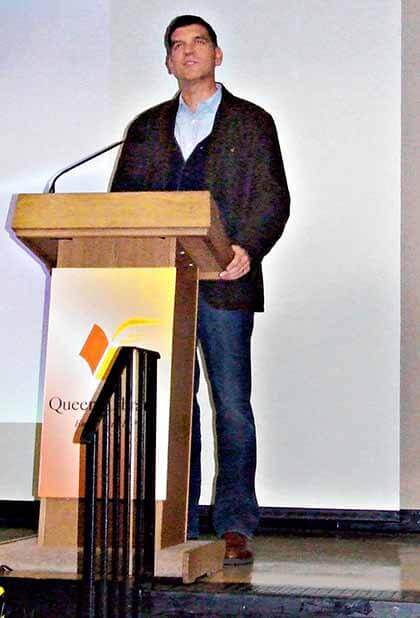By Ivan Pereira
When filmmaker Dale Schierholt was asked to create a documentary on the development of downtown Jamaica since the 1970s, the Maine resident said he had certain preconceptions about the neighborhood — since his sole exposure to it was from negative media coverage.
“I was really expecting a certain kind of place when I got here,” he said. “However, I was surprised to see how different it really was. There was a real story going on here.”
Schierholt’s movie, “Greater Jamaica Development Corporation: Building the Heart of a Community,” shows the positive growth he discovered during his filming from everything to commerce to the arts to community building.
The 60-minute documentary was commissioned by Greater Jamaica as a way to document the years of hard work the nonprofit has done to reverse the decline the downtown area was experiencing during the 1960s. The movie, which includes interviews with a host of southeast Queens figures, including Queens Library Chief Executive Officer Thomas Gallante and Community Board 12 Chairwoman Adoja Gzifa, explains that there was a new shift in the population from middle-class whites to middle-class minority residents during that time.
As the demographics changed, the large retail chains left the downtown shopping center for suburban Long Island and by 1969 Macy’s had closed its doors as part of the white flight from southeast Queens.
The business owners who remained, particularly the ones who lived in the area, decided to band together and work on projects that would help improve the downtown and in 1967 Greater Jamaica was formed.
Schierholt said from the interviews he conducted he saw there was a real passion among residents to show the city why it was a great place to come and visit.
“It was all about organizations and individuals coming together and making a difference,” he said.
The first step was to bring York College to southeast Queens. At the time, CUNY officials were divided between putting the school at Fort Totten or downtown Jamaica and the community came out in droves to demand the school be established in southeast Queens.
Since its opening in 1970, the school has educated thousands of students from all over the borough and has even helped entice major organizations to use the campus space, such as the U.S. Food and Drug Administration.
“It was a great victory that it happened here,” Greater Jamaica President Carlisle Towery said.
Another project showcased in the film is the AirTrain, which began operation in 2003. Some community leaders, such as the Rev. Charles Norris, admits in the movie that they were not initially in favor of the monorail to John F. Kennedy International Airport because they thought it would not benefit the downtown area in the long run.
The dissenters changed their opinion, however, when the city and businesses pledged over the years to transform the AirTrain station at Sutphin Boulevard into a central visitors hub, filled with shops and other venues that would attract travelers who passed through Jamaica to get to and from the airport.
But the movie is not all about infrastructure.
Schierholt said he enjoyed finding out that southeast Queens was home to many jazz artists and the up-and-coming musicians who were following in their footsteps. The movie features a special look at the Jamaica Center for Arts and Learning, which was established in 1972 and has provided classes from painting to dance to artists of all ages.
Leilani Brown, JCAL’s president, is interviewed in the documentary and says JCAL has grown popular over the years.
“We have so much traffic that goes through this area … and we feel this is a special place,” she said.
The director said Greater Jamaica is planning to distribute the movie to PBS stations in New York and show it at events in southeast Queens. Towery commended Schierholt for his work and said he hopes it inspires more progress for the neighborhood in the future.
“There is still much work to be done,” he said.
Reach reporter Ivan Pereira by e-mail at ipereira@cnglocal.com or by phone at 718-260-4546.































